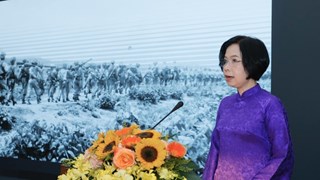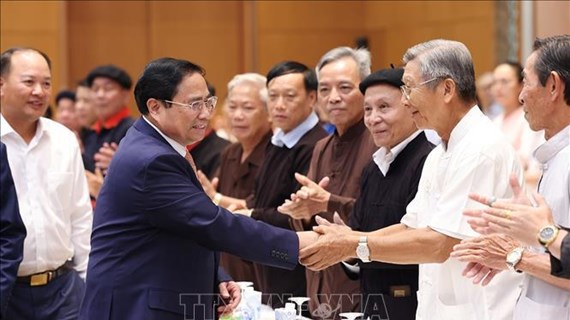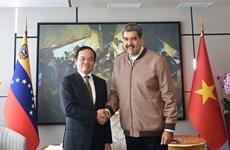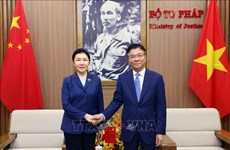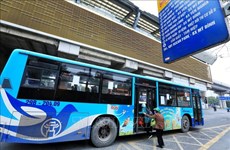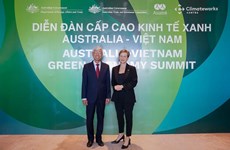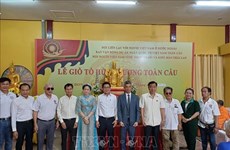Vietnam to step up fight against drug-trafficking
Drug-trafficking at Vietnam’s borders continues to be a major issue, causing law enforcement officers to grow increasingly concerned.
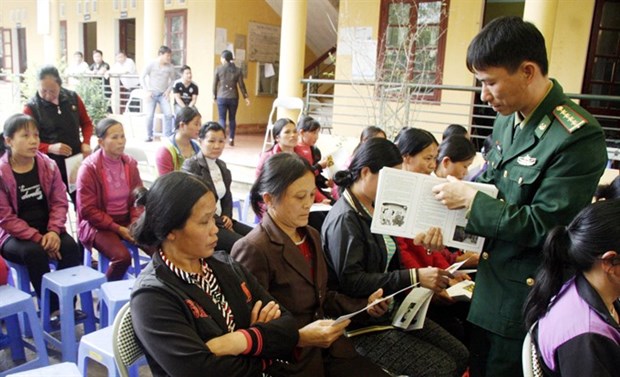 An official from the Na Hinh Border Guard Station delivers leaflets about heroin prevention and control to residents in Thanh Long commune, Van Lang distrrict, the northern mountainous province of Lang Son (Photo: VNA)
An official from the Na Hinh Border Guard Station delivers leaflets about heroin prevention and control to residents in Thanh Long commune, Van Lang distrrict, the northern mountainous province of Lang Son (Photo: VNA)Hanoi (VNA) – Drug-trafficking at Vietnam’s borders continues to be a major issue, causing law enforcement officers to grow increasingly concerned.
Nearly 21,471
drug-trafficking cases were reported in 2017, up 14.5 percent from
2016, according to a report on collaboration among the Police General
Department, the General Department of Vietnam Customs (GDC), Vietnam Border
Guard High Command and Vietnam Coast Guard.
Some 32,950 suspects were
detained, a 13.6 per cent increase over 2016’s figure.
Statistics from the Vietnam
Border Guard showed that the amount of synthetic drugs and marijuana
seized last year through the border of Vietnam and Laos respectively increased
seven times and twice compared with 2016.
Cocaine was transported from
South America to Cambodia and transferred to Vietnam along the Vietnam-Cambodia
border.
Vu Xuan Vien, head of the Police
Advisory Force under the Ministry of Public Security, attributed the prevalence
of drug-trafficking cases to inadequate coordination between police,
border guard, customs and coast guard forces.
The sharing of information
relating to suspects and a shortage of forces on duty at key points poses
challenges to anti-trafficking work.
Nguyen Khanh Quang, deputy
head of the anti-smuggling investigation department under the General
Department of Vietnam Customs (GDVC) acknowledged the problem, telling
the Hai Quan (Custom) newspaper that several cases have been
referred by the GDVC to the police for clarification. However, resolving these
cases took a long time, causing concerns for enterprises.
Some local police delayed or
even refused to provide information or evidence in many cases, he said.
In the meantime, as a rule,
within 24 hours of detecting an incident, customs officers have to finish all
procedures and hand information over to local police.
The lack of clear regulations
on which police force will receive information and evidence from customs units
was also a hindrance.
“The biggest difficulty for
the customs force is that they don’t have the authority to investigate drug
trafficking cases or criminally charge violator,” Quang said.
Predicting that cross-border
crimes relating to drugs would become complicated and rise in the near future,
Vien said leaders of police, customs, border guards and coast guard forces
should work together more regularly.
It was necessary to create a
collaboration mechanism to fight drug trafficking at borders and at sea, he
said.
Each force should take the
initiative in setting plans, assigning duties to each officer and work together
in investigation cases on key routes, particularly from Golden Triangle,
covering Laos.
Vien proposed that forces
should collaborate with local governments in teaching residents to recognise
the harm of drugs, obey laws against drug trafficking crimes and not to take
part in drug-trafficking rings.
To improve the efficiency of
drug prevention and anti-smuggling efforts, Quang suggested strengthening
collaboration between the Police General Department and General Department of
Vietnam Customs.
It was necessary to review
the operations and training courses should be held regularly to enhance officers’
professional skills, he said.
Quang also proposed the
Police General Department include a regulation on protecting national security
in collaboration between the Ministry of Finance and the Ministry of Public
Security.-VNA
